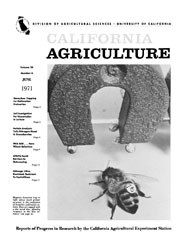


University of California
California Agriculture



|
|||
|
|||

Cover:
Magnetic honeybee trap to right allows much greater accuracy in the evaluation of honeybee pollination activity. Bees are tagged with a tiny metal disc, allowing recapture at the hive entrnnce
June 1971
Volume 25, Number 6 News and opinionGeneral Information |
|||
|
University of California, 1301 S. 46th St., Bldg. 478 Richmond, CA
|